Auditing Report: QEM Limited Financial Statement and Risk Analysis
VerifiedAdded on 2022/11/29
|18
|4182
|438
Report
AI Summary
This report provides a detailed analysis of the auditing process for QEM Limited, an ASX-listed company involved in energy exploration and development. The report begins with an introduction to auditing and its importance in assessing financial statements. It then explores the nature of QEM Limited, its business risks (operational, financial reporting, and compliance risks), and the application of the audit risk model to determine detection risk. Analytical procedures, including ratio analysis (ROCE, current ratio, accounts receivable turnover, and ROE), are performed to identify potential misstatements. The report also covers the calculation of materiality for audit planning. Furthermore, the report analyzes account balances, audit assertions (revenue, expenses, income tax, and cash and cash equivalents), and outlines appropriate audit works and sampling plans for each assertion. The conclusion summarizes the key findings and the overall auditing process for QEM Limited.
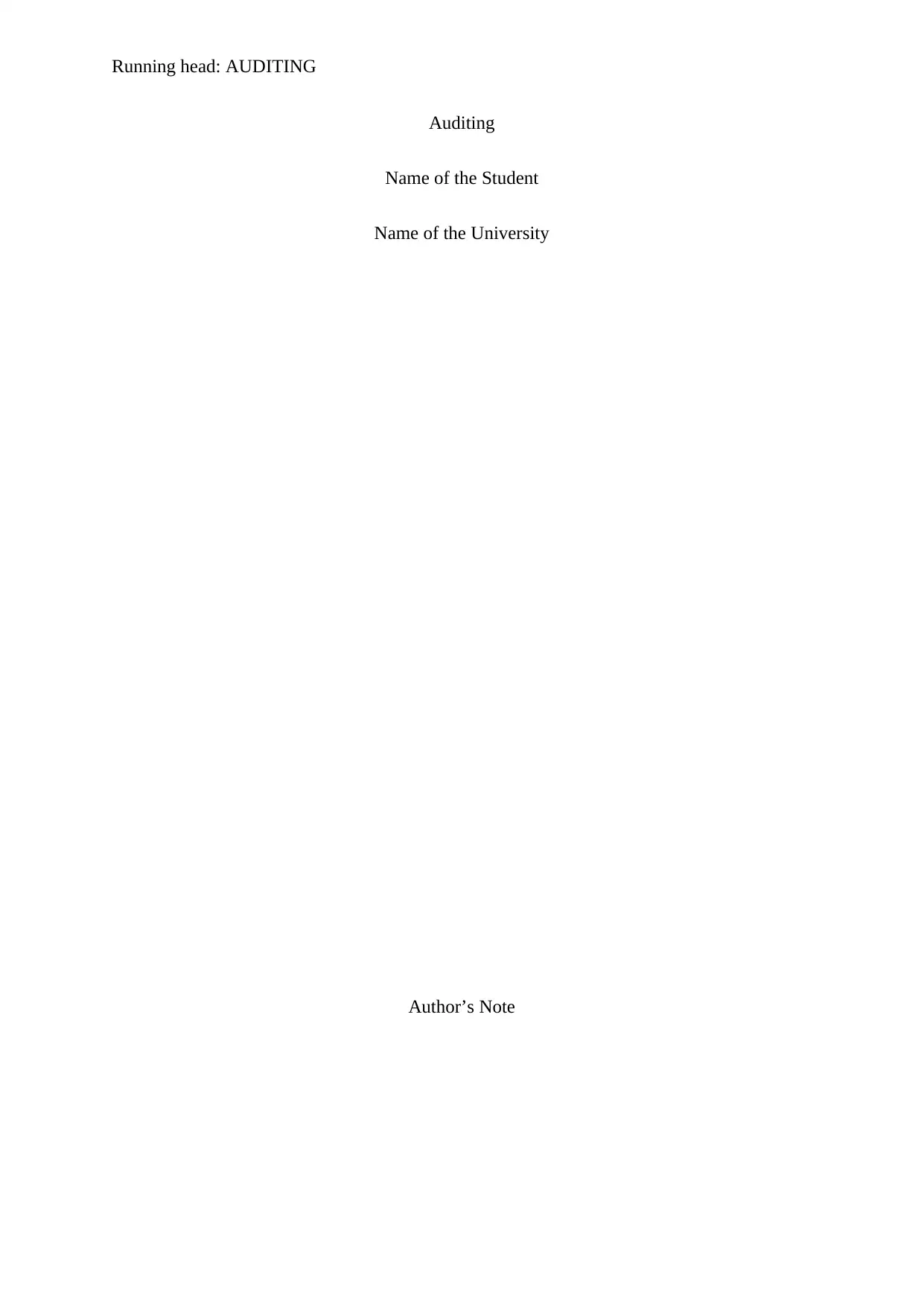
Running head: AUDITING
Auditing
Name of the Student
Name of the University
Author’s Note
Auditing
Name of the Student
Name of the University
Author’s Note
Paraphrase This Document
Need a fresh take? Get an instant paraphrase of this document with our AI Paraphraser
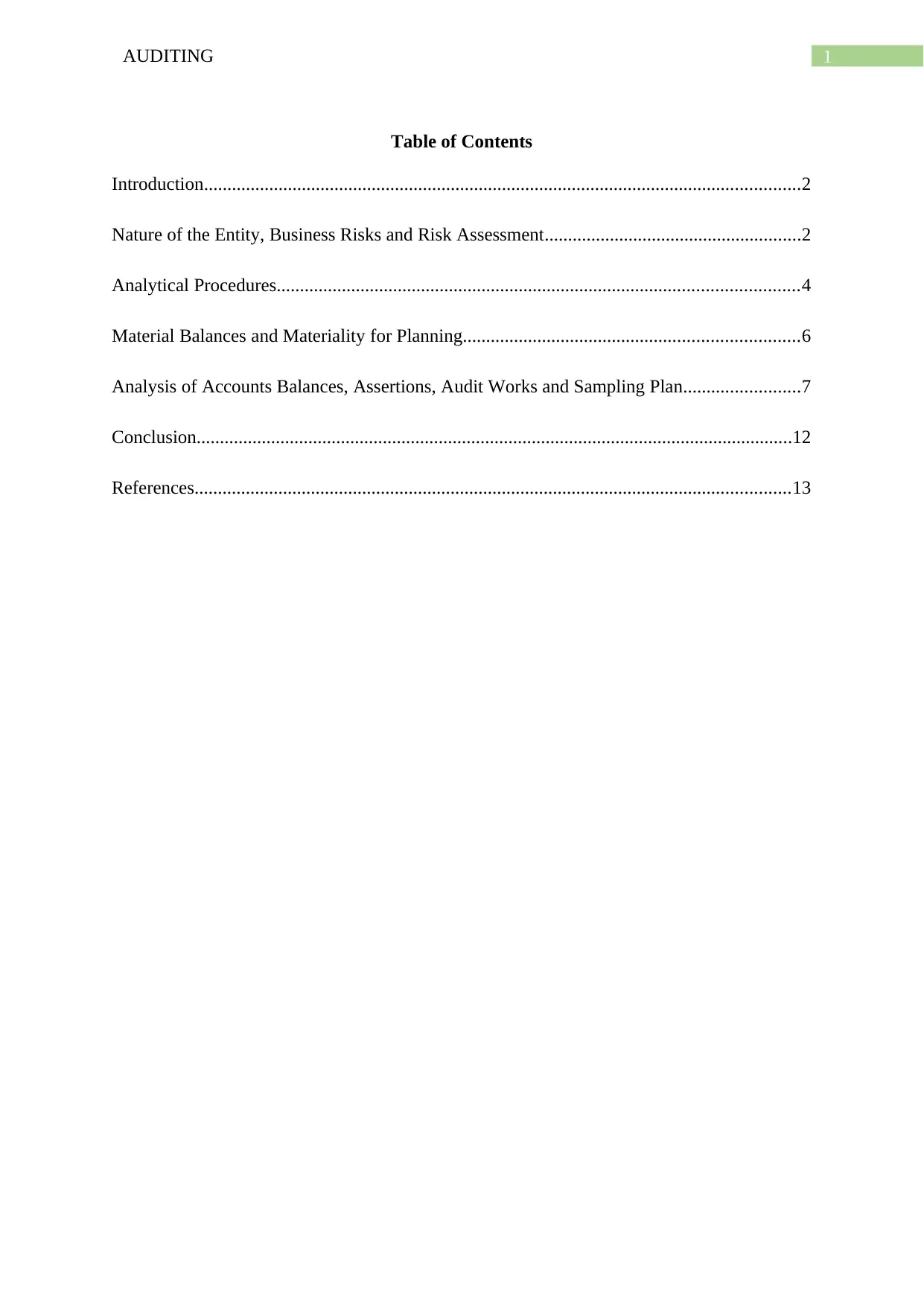
1AUDITING
Table of Contents
Introduction................................................................................................................................2
Nature of the Entity, Business Risks and Risk Assessment.......................................................2
Analytical Procedures................................................................................................................4
Material Balances and Materiality for Planning........................................................................6
Analysis of Accounts Balances, Assertions, Audit Works and Sampling Plan.........................7
Conclusion................................................................................................................................12
References................................................................................................................................13
Table of Contents
Introduction................................................................................................................................2
Nature of the Entity, Business Risks and Risk Assessment.......................................................2
Analytical Procedures................................................................................................................4
Material Balances and Materiality for Planning........................................................................6
Analysis of Accounts Balances, Assertions, Audit Works and Sampling Plan.........................7
Conclusion................................................................................................................................12
References................................................................................................................................13
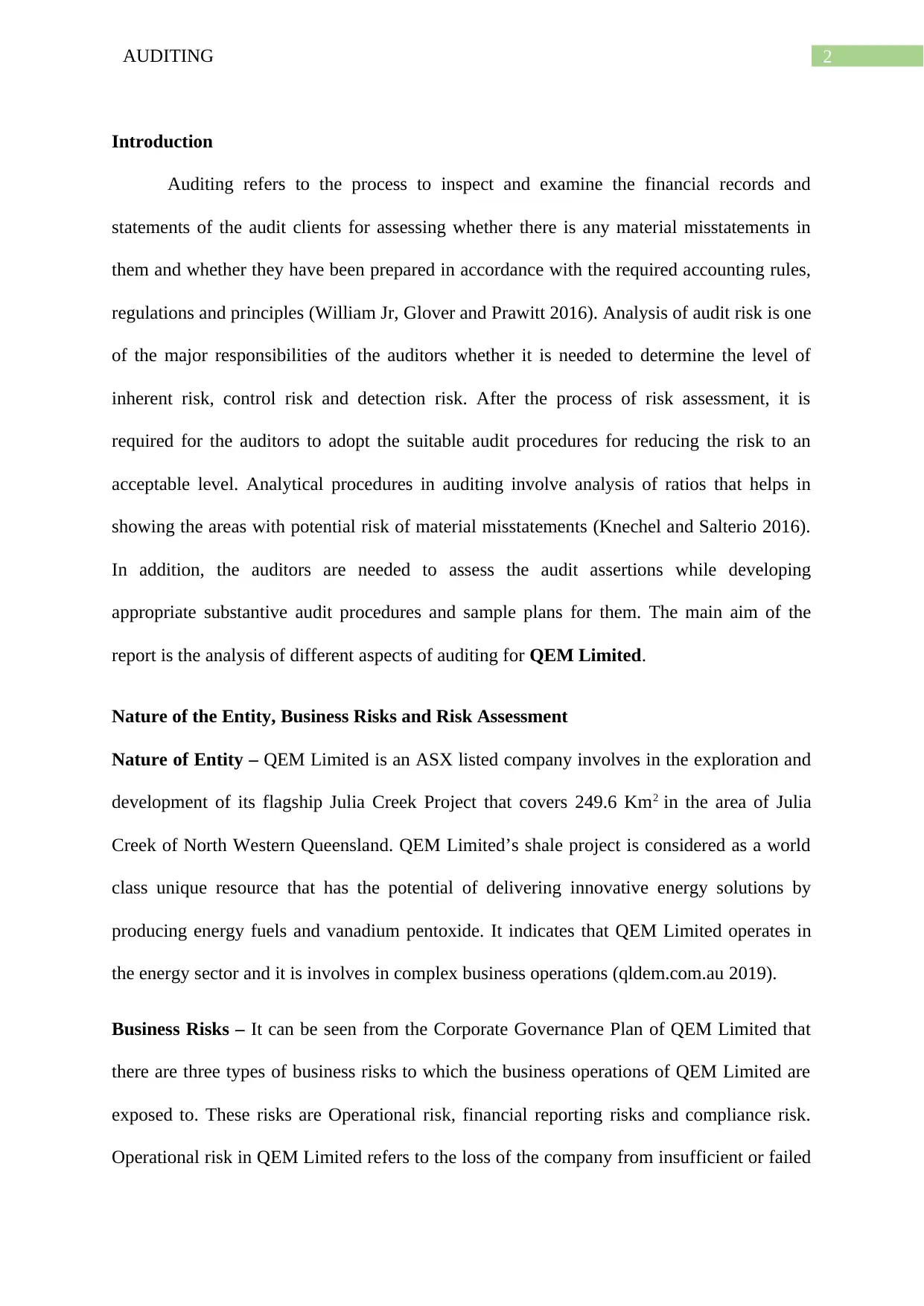
2AUDITING
Introduction
Auditing refers to the process to inspect and examine the financial records and
statements of the audit clients for assessing whether there is any material misstatements in
them and whether they have been prepared in accordance with the required accounting rules,
regulations and principles (William Jr, Glover and Prawitt 2016). Analysis of audit risk is one
of the major responsibilities of the auditors whether it is needed to determine the level of
inherent risk, control risk and detection risk. After the process of risk assessment, it is
required for the auditors to adopt the suitable audit procedures for reducing the risk to an
acceptable level. Analytical procedures in auditing involve analysis of ratios that helps in
showing the areas with potential risk of material misstatements (Knechel and Salterio 2016).
In addition, the auditors are needed to assess the audit assertions while developing
appropriate substantive audit procedures and sample plans for them. The main aim of the
report is the analysis of different aspects of auditing for QEM Limited.
Nature of the Entity, Business Risks and Risk Assessment
Nature of Entity – QEM Limited is an ASX listed company involves in the exploration and
development of its flagship Julia Creek Project that covers 249.6 Km2 in the area of Julia
Creek of North Western Queensland. QEM Limited’s shale project is considered as a world
class unique resource that has the potential of delivering innovative energy solutions by
producing energy fuels and vanadium pentoxide. It indicates that QEM Limited operates in
the energy sector and it is involves in complex business operations (qldem.com.au 2019).
Business Risks – It can be seen from the Corporate Governance Plan of QEM Limited that
there are three types of business risks to which the business operations of QEM Limited are
exposed to. These risks are Operational risk, financial reporting risks and compliance risk.
Operational risk in QEM Limited refers to the loss of the company from insufficient or failed
Introduction
Auditing refers to the process to inspect and examine the financial records and
statements of the audit clients for assessing whether there is any material misstatements in
them and whether they have been prepared in accordance with the required accounting rules,
regulations and principles (William Jr, Glover and Prawitt 2016). Analysis of audit risk is one
of the major responsibilities of the auditors whether it is needed to determine the level of
inherent risk, control risk and detection risk. After the process of risk assessment, it is
required for the auditors to adopt the suitable audit procedures for reducing the risk to an
acceptable level. Analytical procedures in auditing involve analysis of ratios that helps in
showing the areas with potential risk of material misstatements (Knechel and Salterio 2016).
In addition, the auditors are needed to assess the audit assertions while developing
appropriate substantive audit procedures and sample plans for them. The main aim of the
report is the analysis of different aspects of auditing for QEM Limited.
Nature of the Entity, Business Risks and Risk Assessment
Nature of Entity – QEM Limited is an ASX listed company involves in the exploration and
development of its flagship Julia Creek Project that covers 249.6 Km2 in the area of Julia
Creek of North Western Queensland. QEM Limited’s shale project is considered as a world
class unique resource that has the potential of delivering innovative energy solutions by
producing energy fuels and vanadium pentoxide. It indicates that QEM Limited operates in
the energy sector and it is involves in complex business operations (qldem.com.au 2019).
Business Risks – It can be seen from the Corporate Governance Plan of QEM Limited that
there are three types of business risks to which the business operations of QEM Limited are
exposed to. These risks are Operational risk, financial reporting risks and compliance risk.
Operational risk in QEM Limited refers to the loss of the company from insufficient or failed
⊘ This is a preview!⊘
Do you want full access?
Subscribe today to unlock all pages.

Trusted by 1+ million students worldwide
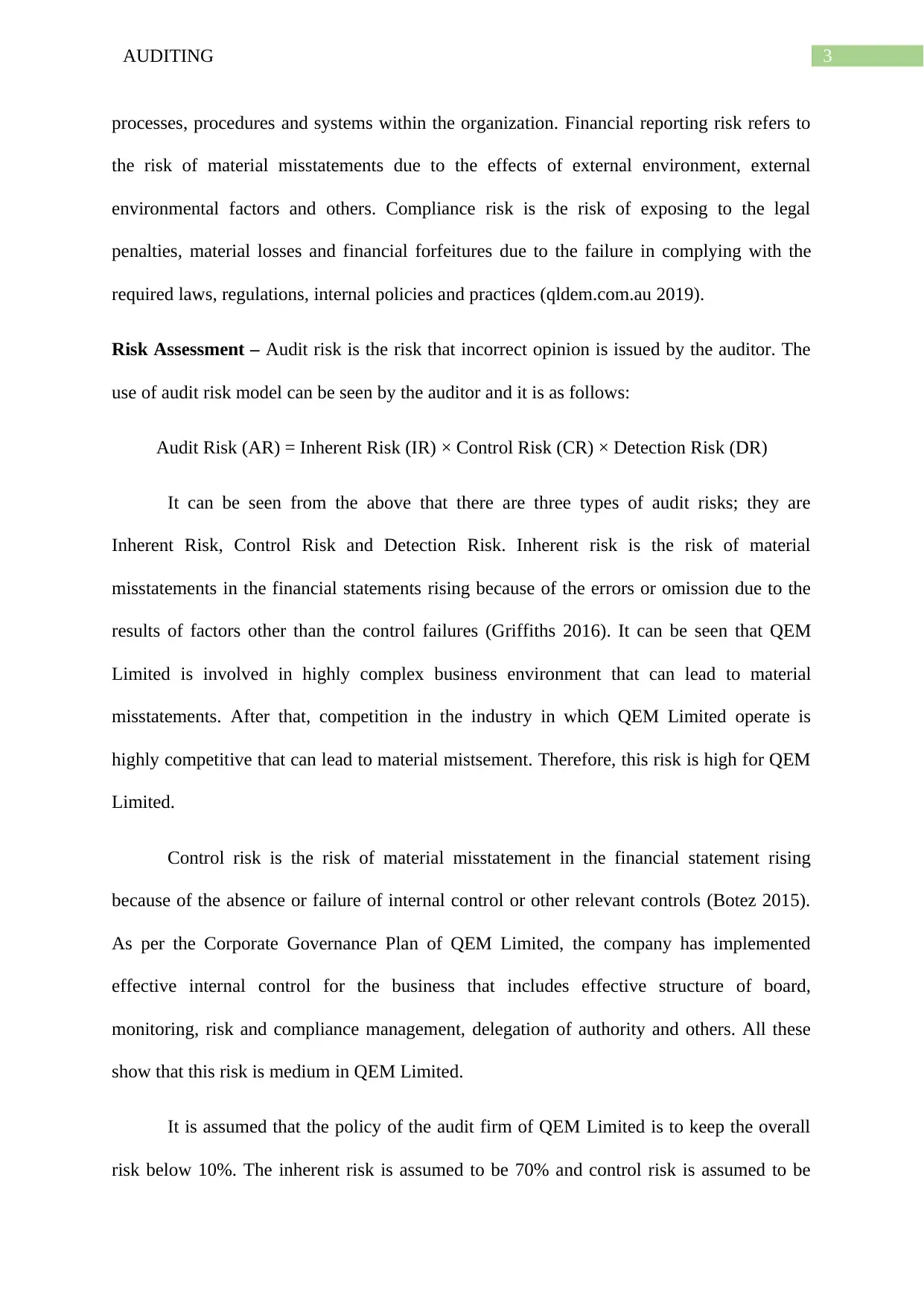
3AUDITING
processes, procedures and systems within the organization. Financial reporting risk refers to
the risk of material misstatements due to the effects of external environment, external
environmental factors and others. Compliance risk is the risk of exposing to the legal
penalties, material losses and financial forfeitures due to the failure in complying with the
required laws, regulations, internal policies and practices (qldem.com.au 2019).
Risk Assessment – Audit risk is the risk that incorrect opinion is issued by the auditor. The
use of audit risk model can be seen by the auditor and it is as follows:
Audit Risk (AR) = Inherent Risk (IR) × Control Risk (CR) × Detection Risk (DR)
It can be seen from the above that there are three types of audit risks; they are
Inherent Risk, Control Risk and Detection Risk. Inherent risk is the risk of material
misstatements in the financial statements rising because of the errors or omission due to the
results of factors other than the control failures (Griffiths 2016). It can be seen that QEM
Limited is involved in highly complex business environment that can lead to material
misstatements. After that, competition in the industry in which QEM Limited operate is
highly competitive that can lead to material mistsement. Therefore, this risk is high for QEM
Limited.
Control risk is the risk of material misstatement in the financial statement rising
because of the absence or failure of internal control or other relevant controls (Botez 2015).
As per the Corporate Governance Plan of QEM Limited, the company has implemented
effective internal control for the business that includes effective structure of board,
monitoring, risk and compliance management, delegation of authority and others. All these
show that this risk is medium in QEM Limited.
It is assumed that the policy of the audit firm of QEM Limited is to keep the overall
risk below 10%. The inherent risk is assumed to be 70% and control risk is assumed to be
processes, procedures and systems within the organization. Financial reporting risk refers to
the risk of material misstatements due to the effects of external environment, external
environmental factors and others. Compliance risk is the risk of exposing to the legal
penalties, material losses and financial forfeitures due to the failure in complying with the
required laws, regulations, internal policies and practices (qldem.com.au 2019).
Risk Assessment – Audit risk is the risk that incorrect opinion is issued by the auditor. The
use of audit risk model can be seen by the auditor and it is as follows:
Audit Risk (AR) = Inherent Risk (IR) × Control Risk (CR) × Detection Risk (DR)
It can be seen from the above that there are three types of audit risks; they are
Inherent Risk, Control Risk and Detection Risk. Inherent risk is the risk of material
misstatements in the financial statements rising because of the errors or omission due to the
results of factors other than the control failures (Griffiths 2016). It can be seen that QEM
Limited is involved in highly complex business environment that can lead to material
misstatements. After that, competition in the industry in which QEM Limited operate is
highly competitive that can lead to material mistsement. Therefore, this risk is high for QEM
Limited.
Control risk is the risk of material misstatement in the financial statement rising
because of the absence or failure of internal control or other relevant controls (Botez 2015).
As per the Corporate Governance Plan of QEM Limited, the company has implemented
effective internal control for the business that includes effective structure of board,
monitoring, risk and compliance management, delegation of authority and others. All these
show that this risk is medium in QEM Limited.
It is assumed that the policy of the audit firm of QEM Limited is to keep the overall
risk below 10%. The inherent risk is assumed to be 70% and control risk is assumed to be
Paraphrase This Document
Need a fresh take? Get an instant paraphrase of this document with our AI Paraphraser
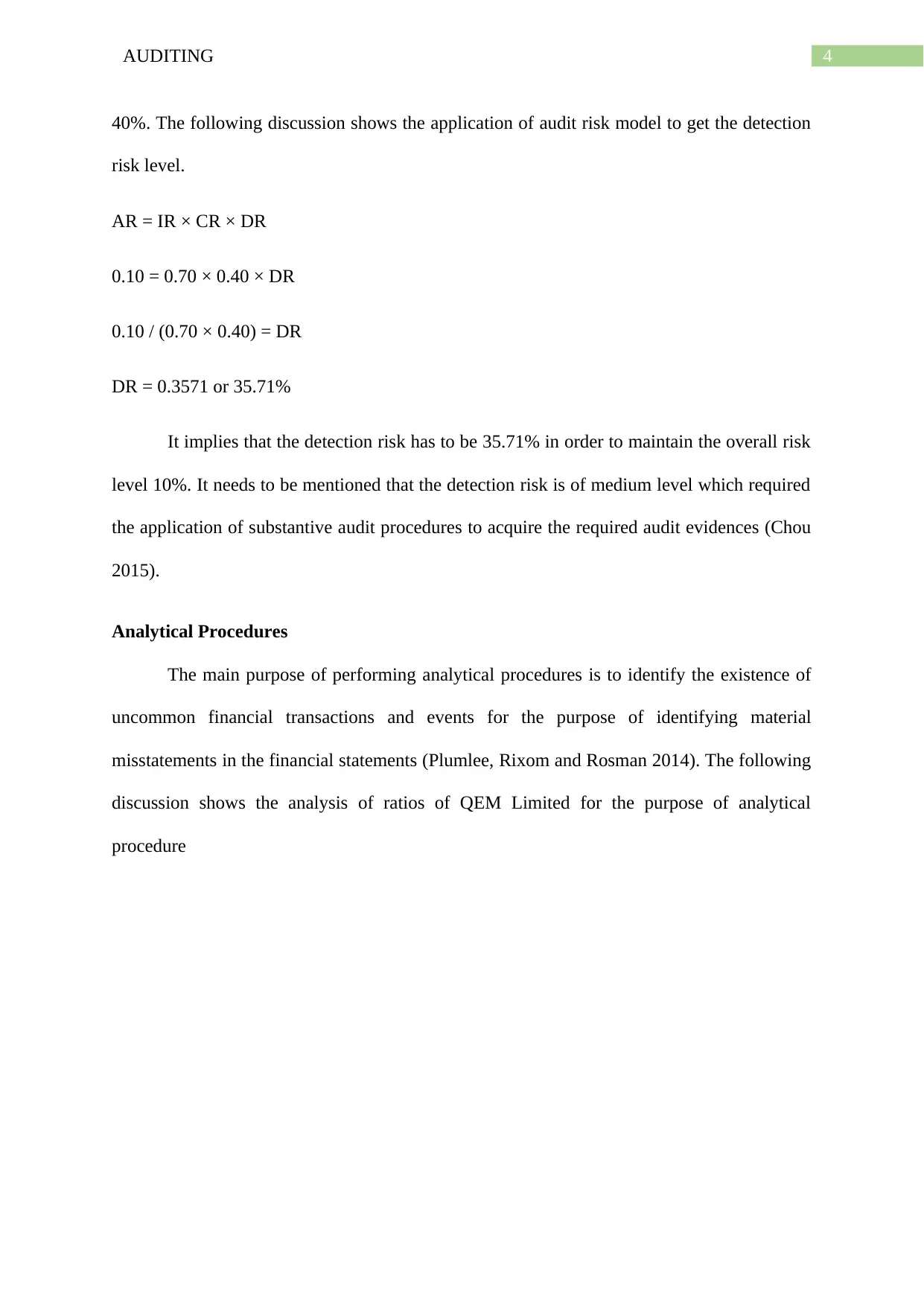
4AUDITING
40%. The following discussion shows the application of audit risk model to get the detection
risk level.
AR = IR × CR × DR
0.10 = 0.70 × 0.40 × DR
0.10 / (0.70 × 0.40) = DR
DR = 0.3571 or 35.71%
It implies that the detection risk has to be 35.71% in order to maintain the overall risk
level 10%. It needs to be mentioned that the detection risk is of medium level which required
the application of substantive audit procedures to acquire the required audit evidences (Chou
2015).
Analytical Procedures
The main purpose of performing analytical procedures is to identify the existence of
uncommon financial transactions and events for the purpose of identifying material
misstatements in the financial statements (Plumlee, Rixom and Rosman 2014). The following
discussion shows the analysis of ratios of QEM Limited for the purpose of analytical
procedure
40%. The following discussion shows the application of audit risk model to get the detection
risk level.
AR = IR × CR × DR
0.10 = 0.70 × 0.40 × DR
0.10 / (0.70 × 0.40) = DR
DR = 0.3571 or 35.71%
It implies that the detection risk has to be 35.71% in order to maintain the overall risk
level 10%. It needs to be mentioned that the detection risk is of medium level which required
the application of substantive audit procedures to acquire the required audit evidences (Chou
2015).
Analytical Procedures
The main purpose of performing analytical procedures is to identify the existence of
uncommon financial transactions and events for the purpose of identifying material
misstatements in the financial statements (Plumlee, Rixom and Rosman 2014). The following
discussion shows the analysis of ratios of QEM Limited for the purpose of analytical
procedure
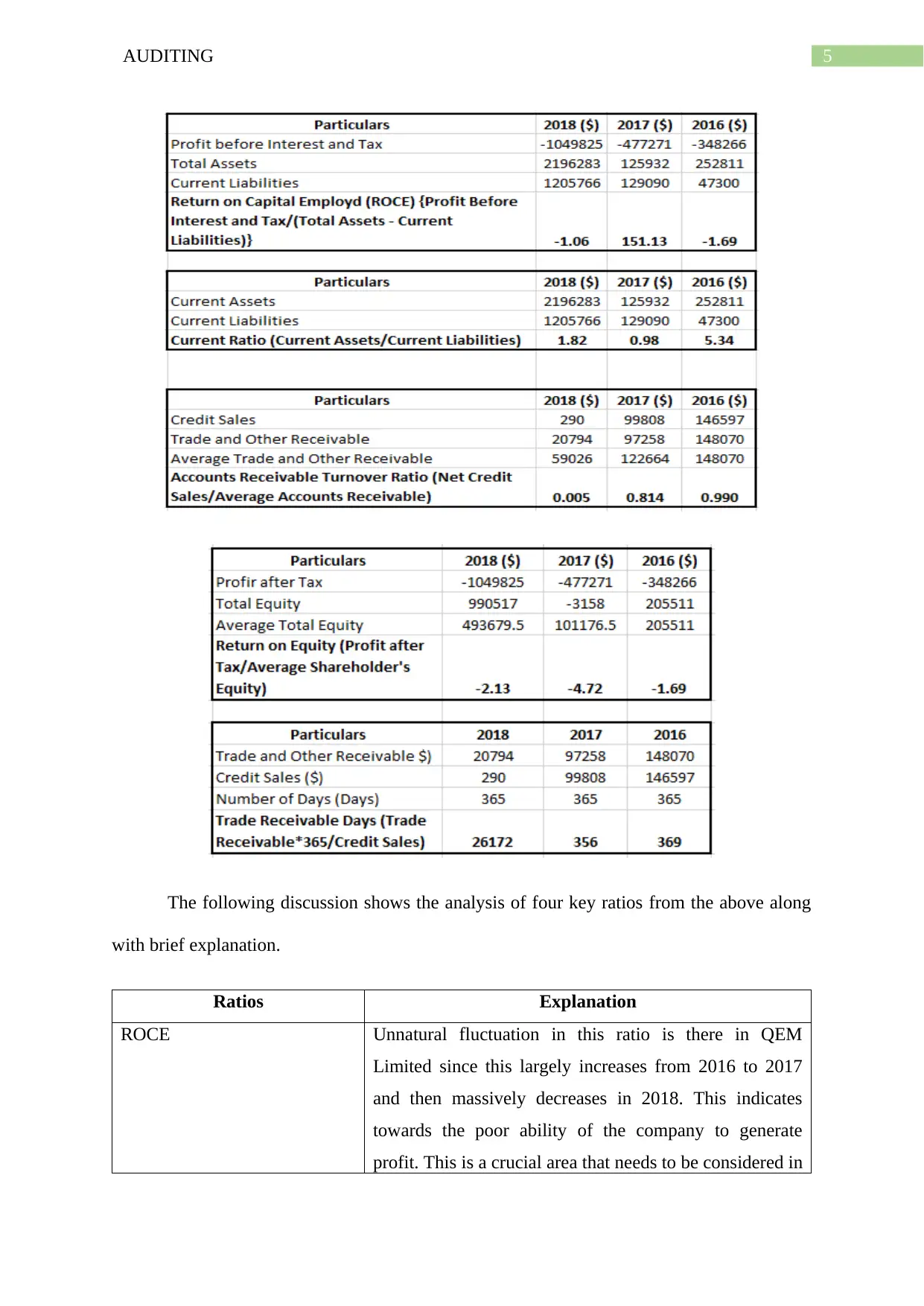
5AUDITING
The following discussion shows the analysis of four key ratios from the above along
with brief explanation.
Ratios Explanation
ROCE Unnatural fluctuation in this ratio is there in QEM
Limited since this largely increases from 2016 to 2017
and then massively decreases in 2018. This indicates
towards the poor ability of the company to generate
profit. This is a crucial area that needs to be considered in
The following discussion shows the analysis of four key ratios from the above along
with brief explanation.
Ratios Explanation
ROCE Unnatural fluctuation in this ratio is there in QEM
Limited since this largely increases from 2016 to 2017
and then massively decreases in 2018. This indicates
towards the poor ability of the company to generate
profit. This is a crucial area that needs to be considered in
⊘ This is a preview!⊘
Do you want full access?
Subscribe today to unlock all pages.

Trusted by 1+ million students worldwide
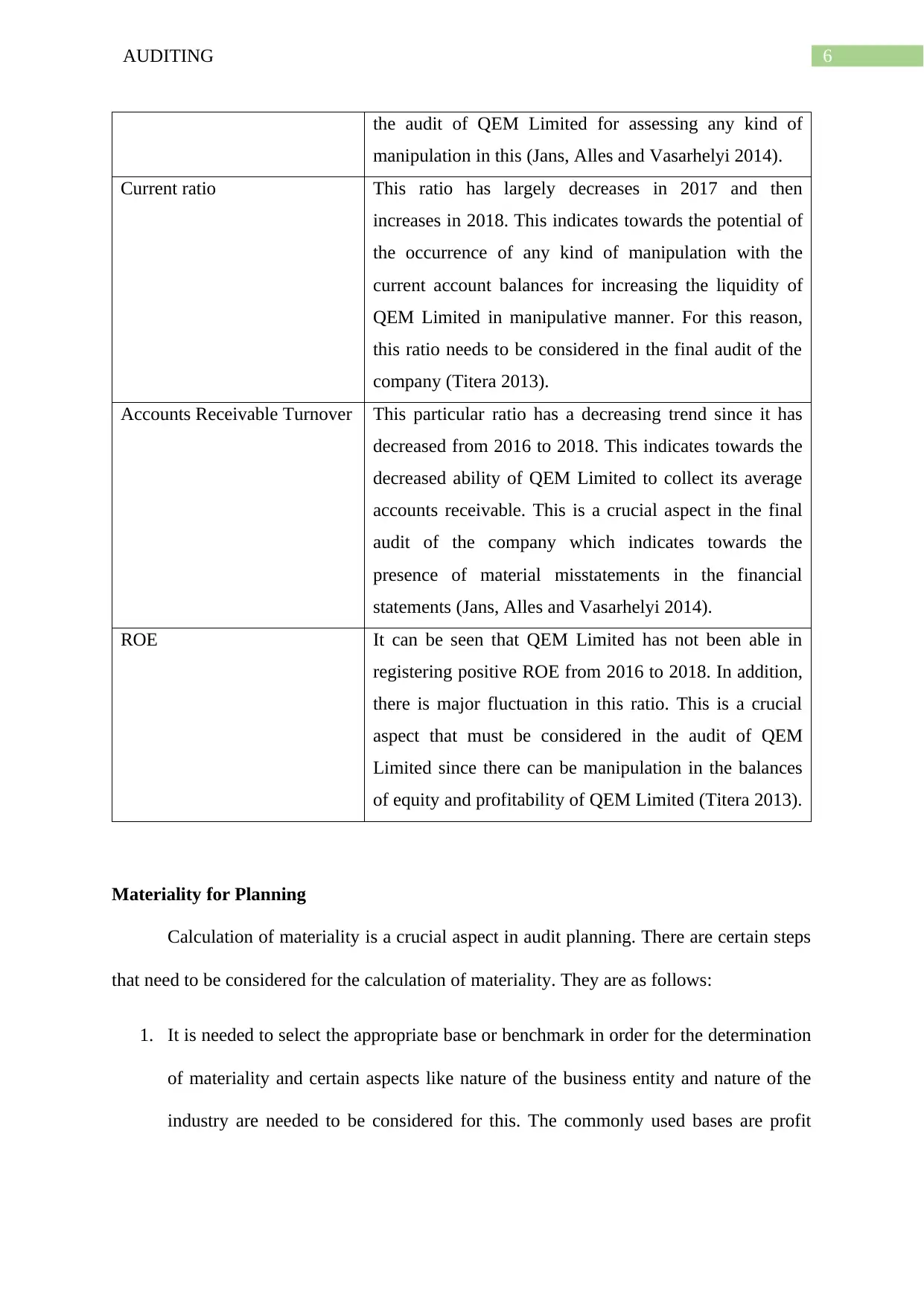
6AUDITING
the audit of QEM Limited for assessing any kind of
manipulation in this (Jans, Alles and Vasarhelyi 2014).
Current ratio This ratio has largely decreases in 2017 and then
increases in 2018. This indicates towards the potential of
the occurrence of any kind of manipulation with the
current account balances for increasing the liquidity of
QEM Limited in manipulative manner. For this reason,
this ratio needs to be considered in the final audit of the
company (Titera 2013).
Accounts Receivable Turnover This particular ratio has a decreasing trend since it has
decreased from 2016 to 2018. This indicates towards the
decreased ability of QEM Limited to collect its average
accounts receivable. This is a crucial aspect in the final
audit of the company which indicates towards the
presence of material misstatements in the financial
statements (Jans, Alles and Vasarhelyi 2014).
ROE It can be seen that QEM Limited has not been able in
registering positive ROE from 2016 to 2018. In addition,
there is major fluctuation in this ratio. This is a crucial
aspect that must be considered in the audit of QEM
Limited since there can be manipulation in the balances
of equity and profitability of QEM Limited (Titera 2013).
Materiality for Planning
Calculation of materiality is a crucial aspect in audit planning. There are certain steps
that need to be considered for the calculation of materiality. They are as follows:
1. It is needed to select the appropriate base or benchmark in order for the determination
of materiality and certain aspects like nature of the business entity and nature of the
industry are needed to be considered for this. The commonly used bases are profit
the audit of QEM Limited for assessing any kind of
manipulation in this (Jans, Alles and Vasarhelyi 2014).
Current ratio This ratio has largely decreases in 2017 and then
increases in 2018. This indicates towards the potential of
the occurrence of any kind of manipulation with the
current account balances for increasing the liquidity of
QEM Limited in manipulative manner. For this reason,
this ratio needs to be considered in the final audit of the
company (Titera 2013).
Accounts Receivable Turnover This particular ratio has a decreasing trend since it has
decreased from 2016 to 2018. This indicates towards the
decreased ability of QEM Limited to collect its average
accounts receivable. This is a crucial aspect in the final
audit of the company which indicates towards the
presence of material misstatements in the financial
statements (Jans, Alles and Vasarhelyi 2014).
ROE It can be seen that QEM Limited has not been able in
registering positive ROE from 2016 to 2018. In addition,
there is major fluctuation in this ratio. This is a crucial
aspect that must be considered in the audit of QEM
Limited since there can be manipulation in the balances
of equity and profitability of QEM Limited (Titera 2013).
Materiality for Planning
Calculation of materiality is a crucial aspect in audit planning. There are certain steps
that need to be considered for the calculation of materiality. They are as follows:
1. It is needed to select the appropriate base or benchmark in order for the determination
of materiality and certain aspects like nature of the business entity and nature of the
industry are needed to be considered for this. The commonly used bases are profit
Paraphrase This Document
Need a fresh take? Get an instant paraphrase of this document with our AI Paraphraser
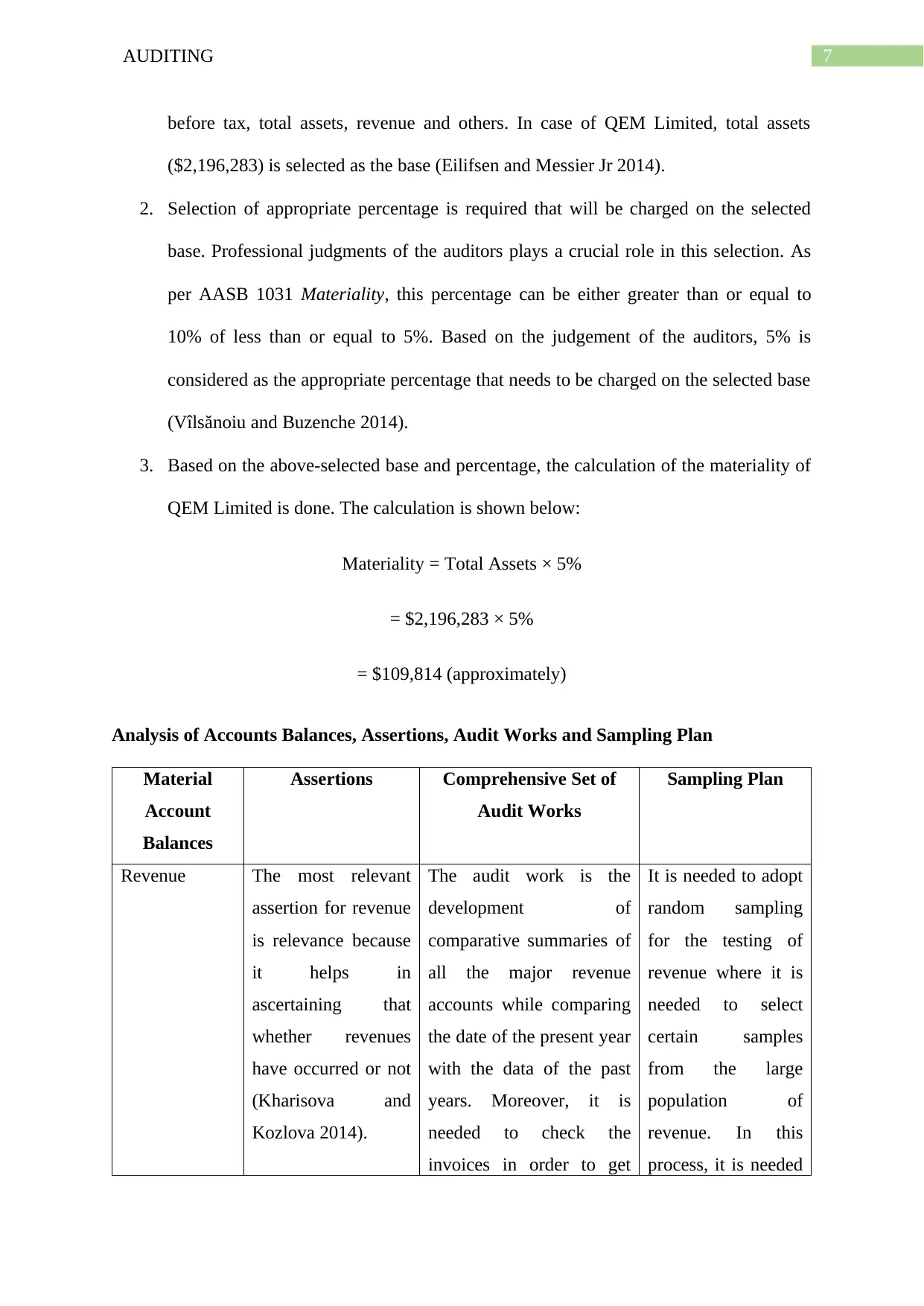
7AUDITING
before tax, total assets, revenue and others. In case of QEM Limited, total assets
($2,196,283) is selected as the base (Eilifsen and Messier Jr 2014).
2. Selection of appropriate percentage is required that will be charged on the selected
base. Professional judgments of the auditors plays a crucial role in this selection. As
per AASB 1031 Materiality, this percentage can be either greater than or equal to
10% of less than or equal to 5%. Based on the judgement of the auditors, 5% is
considered as the appropriate percentage that needs to be charged on the selected base
(Vîlsănoiu and Buzenche 2014).
3. Based on the above-selected base and percentage, the calculation of the materiality of
QEM Limited is done. The calculation is shown below:
Materiality = Total Assets × 5%
= $2,196,283 × 5%
= $109,814 (approximately)
Analysis of Accounts Balances, Assertions, Audit Works and Sampling Plan
Material
Account
Balances
Assertions Comprehensive Set of
Audit Works
Sampling Plan
Revenue The most relevant
assertion for revenue
is relevance because
it helps in
ascertaining that
whether revenues
have occurred or not
(Kharisova and
Kozlova 2014).
The audit work is the
development of
comparative summaries of
all the major revenue
accounts while comparing
the date of the present year
with the data of the past
years. Moreover, it is
needed to check the
invoices in order to get
It is needed to adopt
random sampling
for the testing of
revenue where it is
needed to select
certain samples
from the large
population of
revenue. In this
process, it is needed
before tax, total assets, revenue and others. In case of QEM Limited, total assets
($2,196,283) is selected as the base (Eilifsen and Messier Jr 2014).
2. Selection of appropriate percentage is required that will be charged on the selected
base. Professional judgments of the auditors plays a crucial role in this selection. As
per AASB 1031 Materiality, this percentage can be either greater than or equal to
10% of less than or equal to 5%. Based on the judgement of the auditors, 5% is
considered as the appropriate percentage that needs to be charged on the selected base
(Vîlsănoiu and Buzenche 2014).
3. Based on the above-selected base and percentage, the calculation of the materiality of
QEM Limited is done. The calculation is shown below:
Materiality = Total Assets × 5%
= $2,196,283 × 5%
= $109,814 (approximately)
Analysis of Accounts Balances, Assertions, Audit Works and Sampling Plan
Material
Account
Balances
Assertions Comprehensive Set of
Audit Works
Sampling Plan
Revenue The most relevant
assertion for revenue
is relevance because
it helps in
ascertaining that
whether revenues
have occurred or not
(Kharisova and
Kozlova 2014).
The audit work is the
development of
comparative summaries of
all the major revenue
accounts while comparing
the date of the present year
with the data of the past
years. Moreover, it is
needed to check the
invoices in order to get
It is needed to adopt
random sampling
for the testing of
revenue where it is
needed to select
certain samples
from the large
population of
revenue. In this
process, it is needed
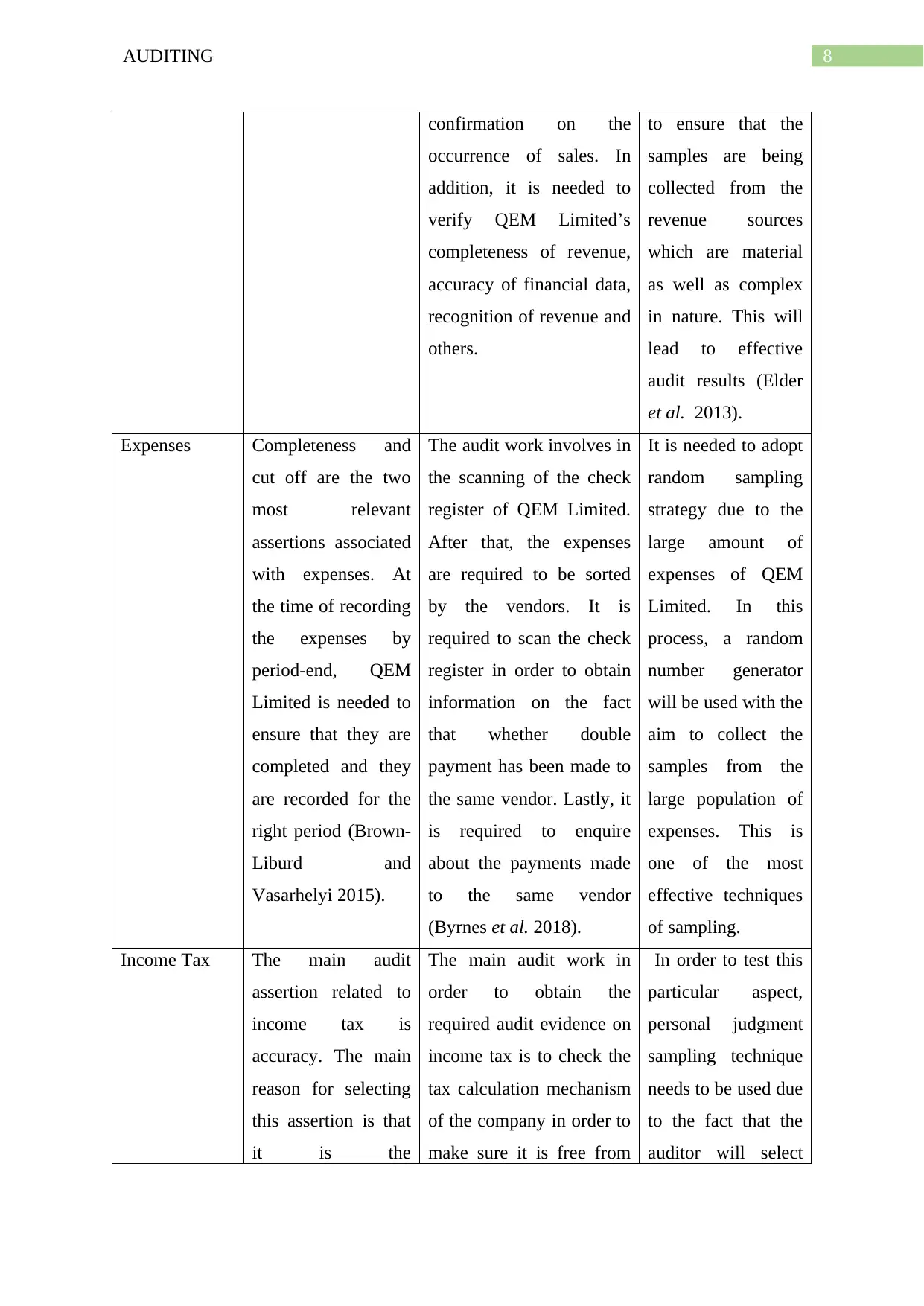
8AUDITING
confirmation on the
occurrence of sales. In
addition, it is needed to
verify QEM Limited’s
completeness of revenue,
accuracy of financial data,
recognition of revenue and
others.
to ensure that the
samples are being
collected from the
revenue sources
which are material
as well as complex
in nature. This will
lead to effective
audit results (Elder
et al. 2013).
Expenses Completeness and
cut off are the two
most relevant
assertions associated
with expenses. At
the time of recording
the expenses by
period-end, QEM
Limited is needed to
ensure that they are
completed and they
are recorded for the
right period (Brown-
Liburd and
Vasarhelyi 2015).
The audit work involves in
the scanning of the check
register of QEM Limited.
After that, the expenses
are required to be sorted
by the vendors. It is
required to scan the check
register in order to obtain
information on the fact
that whether double
payment has been made to
the same vendor. Lastly, it
is required to enquire
about the payments made
to the same vendor
(Byrnes et al. 2018).
It is needed to adopt
random sampling
strategy due to the
large amount of
expenses of QEM
Limited. In this
process, a random
number generator
will be used with the
aim to collect the
samples from the
large population of
expenses. This is
one of the most
effective techniques
of sampling.
Income Tax The main audit
assertion related to
income tax is
accuracy. The main
reason for selecting
this assertion is that
it is the
The main audit work in
order to obtain the
required audit evidence on
income tax is to check the
tax calculation mechanism
of the company in order to
make sure it is free from
In order to test this
particular aspect,
personal judgment
sampling technique
needs to be used due
to the fact that the
auditor will select
confirmation on the
occurrence of sales. In
addition, it is needed to
verify QEM Limited’s
completeness of revenue,
accuracy of financial data,
recognition of revenue and
others.
to ensure that the
samples are being
collected from the
revenue sources
which are material
as well as complex
in nature. This will
lead to effective
audit results (Elder
et al. 2013).
Expenses Completeness and
cut off are the two
most relevant
assertions associated
with expenses. At
the time of recording
the expenses by
period-end, QEM
Limited is needed to
ensure that they are
completed and they
are recorded for the
right period (Brown-
Liburd and
Vasarhelyi 2015).
The audit work involves in
the scanning of the check
register of QEM Limited.
After that, the expenses
are required to be sorted
by the vendors. It is
required to scan the check
register in order to obtain
information on the fact
that whether double
payment has been made to
the same vendor. Lastly, it
is required to enquire
about the payments made
to the same vendor
(Byrnes et al. 2018).
It is needed to adopt
random sampling
strategy due to the
large amount of
expenses of QEM
Limited. In this
process, a random
number generator
will be used with the
aim to collect the
samples from the
large population of
expenses. This is
one of the most
effective techniques
of sampling.
Income Tax The main audit
assertion related to
income tax is
accuracy. The main
reason for selecting
this assertion is that
it is the
The main audit work in
order to obtain the
required audit evidence on
income tax is to check the
tax calculation mechanism
of the company in order to
make sure it is free from
In order to test this
particular aspect,
personal judgment
sampling technique
needs to be used due
to the fact that the
auditor will select
⊘ This is a preview!⊘
Do you want full access?
Subscribe today to unlock all pages.

Trusted by 1+ million students worldwide
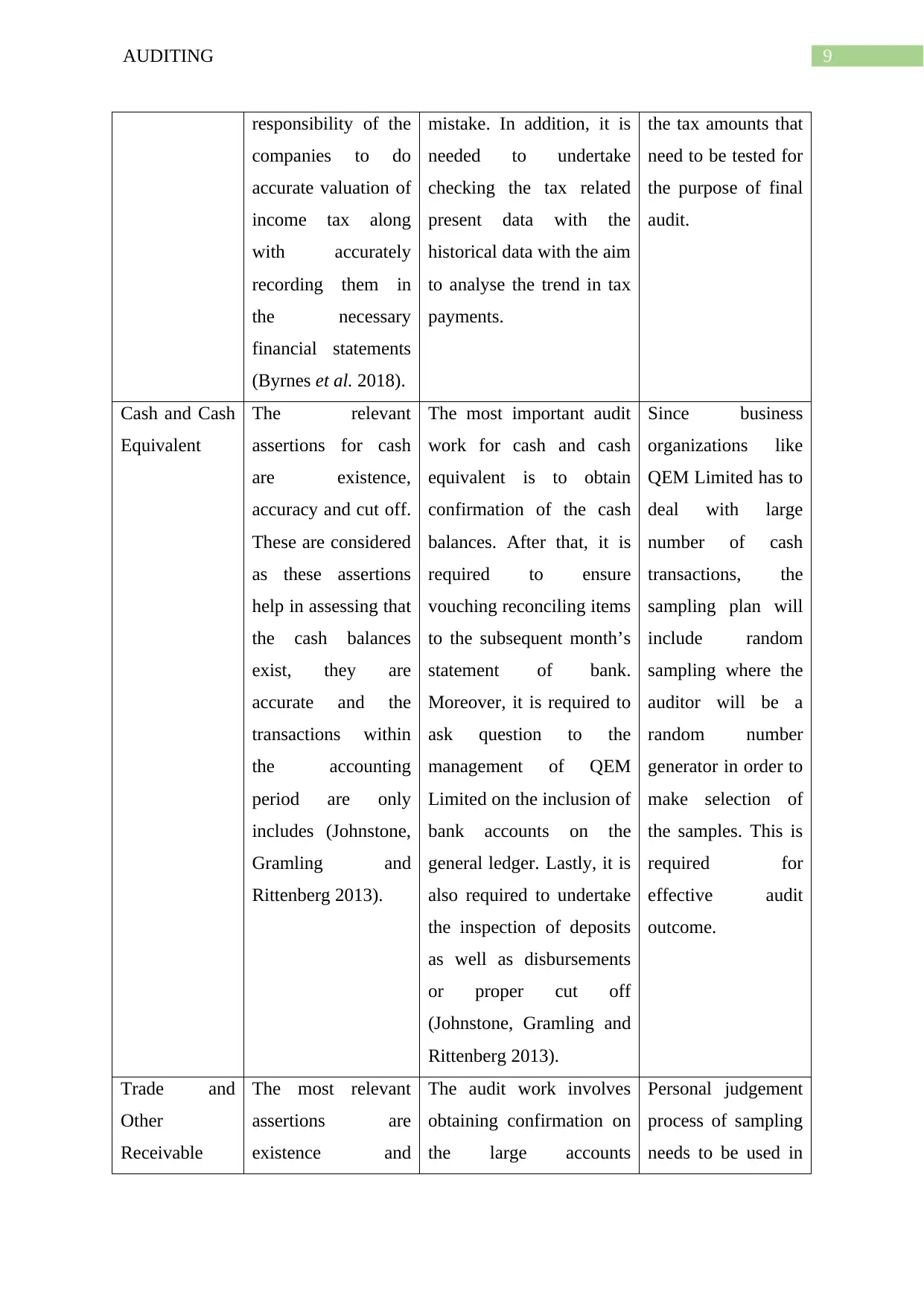
9AUDITING
responsibility of the
companies to do
accurate valuation of
income tax along
with accurately
recording them in
the necessary
financial statements
(Byrnes et al. 2018).
mistake. In addition, it is
needed to undertake
checking the tax related
present data with the
historical data with the aim
to analyse the trend in tax
payments.
the tax amounts that
need to be tested for
the purpose of final
audit.
Cash and Cash
Equivalent
The relevant
assertions for cash
are existence,
accuracy and cut off.
These are considered
as these assertions
help in assessing that
the cash balances
exist, they are
accurate and the
transactions within
the accounting
period are only
includes (Johnstone,
Gramling and
Rittenberg 2013).
The most important audit
work for cash and cash
equivalent is to obtain
confirmation of the cash
balances. After that, it is
required to ensure
vouching reconciling items
to the subsequent month’s
statement of bank.
Moreover, it is required to
ask question to the
management of QEM
Limited on the inclusion of
bank accounts on the
general ledger. Lastly, it is
also required to undertake
the inspection of deposits
as well as disbursements
or proper cut off
(Johnstone, Gramling and
Rittenberg 2013).
Since business
organizations like
QEM Limited has to
deal with large
number of cash
transactions, the
sampling plan will
include random
sampling where the
auditor will be a
random number
generator in order to
make selection of
the samples. This is
required for
effective audit
outcome.
Trade and
Other
Receivable
The most relevant
assertions are
existence and
The audit work involves
obtaining confirmation on
the large accounts
Personal judgement
process of sampling
needs to be used in
responsibility of the
companies to do
accurate valuation of
income tax along
with accurately
recording them in
the necessary
financial statements
(Byrnes et al. 2018).
mistake. In addition, it is
needed to undertake
checking the tax related
present data with the
historical data with the aim
to analyse the trend in tax
payments.
the tax amounts that
need to be tested for
the purpose of final
audit.
Cash and Cash
Equivalent
The relevant
assertions for cash
are existence,
accuracy and cut off.
These are considered
as these assertions
help in assessing that
the cash balances
exist, they are
accurate and the
transactions within
the accounting
period are only
includes (Johnstone,
Gramling and
Rittenberg 2013).
The most important audit
work for cash and cash
equivalent is to obtain
confirmation of the cash
balances. After that, it is
required to ensure
vouching reconciling items
to the subsequent month’s
statement of bank.
Moreover, it is required to
ask question to the
management of QEM
Limited on the inclusion of
bank accounts on the
general ledger. Lastly, it is
also required to undertake
the inspection of deposits
as well as disbursements
or proper cut off
(Johnstone, Gramling and
Rittenberg 2013).
Since business
organizations like
QEM Limited has to
deal with large
number of cash
transactions, the
sampling plan will
include random
sampling where the
auditor will be a
random number
generator in order to
make selection of
the samples. This is
required for
effective audit
outcome.
Trade and
Other
Receivable
The most relevant
assertions are
existence and
The audit work involves
obtaining confirmation on
the large accounts
Personal judgement
process of sampling
needs to be used in
Paraphrase This Document
Need a fresh take? Get an instant paraphrase of this document with our AI Paraphraser
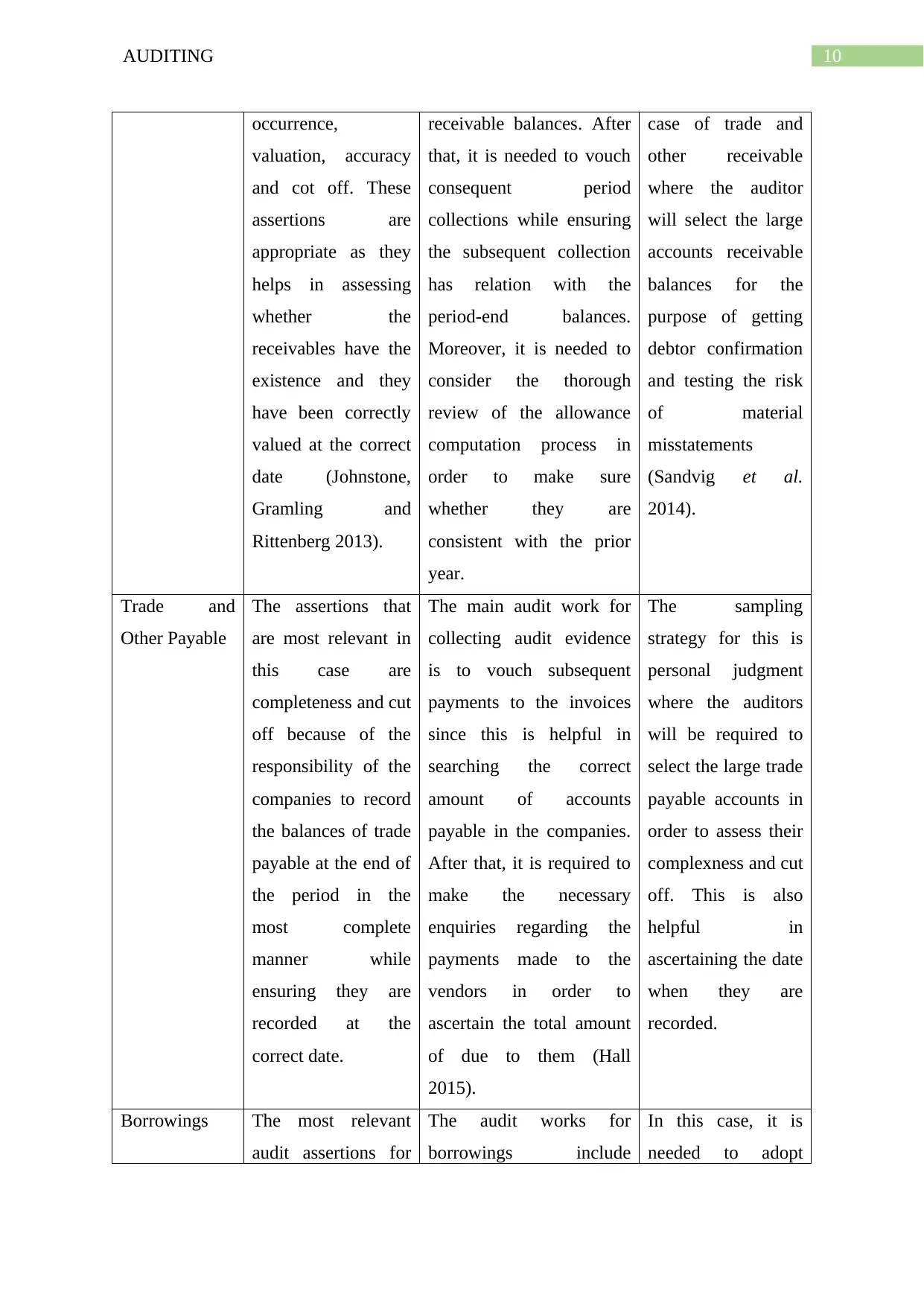
10AUDITING
occurrence,
valuation, accuracy
and cot off. These
assertions are
appropriate as they
helps in assessing
whether the
receivables have the
existence and they
have been correctly
valued at the correct
date (Johnstone,
Gramling and
Rittenberg 2013).
receivable balances. After
that, it is needed to vouch
consequent period
collections while ensuring
the subsequent collection
has relation with the
period-end balances.
Moreover, it is needed to
consider the thorough
review of the allowance
computation process in
order to make sure
whether they are
consistent with the prior
year.
case of trade and
other receivable
where the auditor
will select the large
accounts receivable
balances for the
purpose of getting
debtor confirmation
and testing the risk
of material
misstatements
(Sandvig et al.
2014).
Trade and
Other Payable
The assertions that
are most relevant in
this case are
completeness and cut
off because of the
responsibility of the
companies to record
the balances of trade
payable at the end of
the period in the
most complete
manner while
ensuring they are
recorded at the
correct date.
The main audit work for
collecting audit evidence
is to vouch subsequent
payments to the invoices
since this is helpful in
searching the correct
amount of accounts
payable in the companies.
After that, it is required to
make the necessary
enquiries regarding the
payments made to the
vendors in order to
ascertain the total amount
of due to them (Hall
2015).
The sampling
strategy for this is
personal judgment
where the auditors
will be required to
select the large trade
payable accounts in
order to assess their
complexness and cut
off. This is also
helpful in
ascertaining the date
when they are
recorded.
Borrowings The most relevant
audit assertions for
The audit works for
borrowings include
In this case, it is
needed to adopt
occurrence,
valuation, accuracy
and cot off. These
assertions are
appropriate as they
helps in assessing
whether the
receivables have the
existence and they
have been correctly
valued at the correct
date (Johnstone,
Gramling and
Rittenberg 2013).
receivable balances. After
that, it is needed to vouch
consequent period
collections while ensuring
the subsequent collection
has relation with the
period-end balances.
Moreover, it is needed to
consider the thorough
review of the allowance
computation process in
order to make sure
whether they are
consistent with the prior
year.
case of trade and
other receivable
where the auditor
will select the large
accounts receivable
balances for the
purpose of getting
debtor confirmation
and testing the risk
of material
misstatements
(Sandvig et al.
2014).
Trade and
Other Payable
The assertions that
are most relevant in
this case are
completeness and cut
off because of the
responsibility of the
companies to record
the balances of trade
payable at the end of
the period in the
most complete
manner while
ensuring they are
recorded at the
correct date.
The main audit work for
collecting audit evidence
is to vouch subsequent
payments to the invoices
since this is helpful in
searching the correct
amount of accounts
payable in the companies.
After that, it is required to
make the necessary
enquiries regarding the
payments made to the
vendors in order to
ascertain the total amount
of due to them (Hall
2015).
The sampling
strategy for this is
personal judgment
where the auditors
will be required to
select the large trade
payable accounts in
order to assess their
complexness and cut
off. This is also
helpful in
ascertaining the date
when they are
recorded.
Borrowings The most relevant
audit assertions for
The audit works for
borrowings include
In this case, it is
needed to adopt
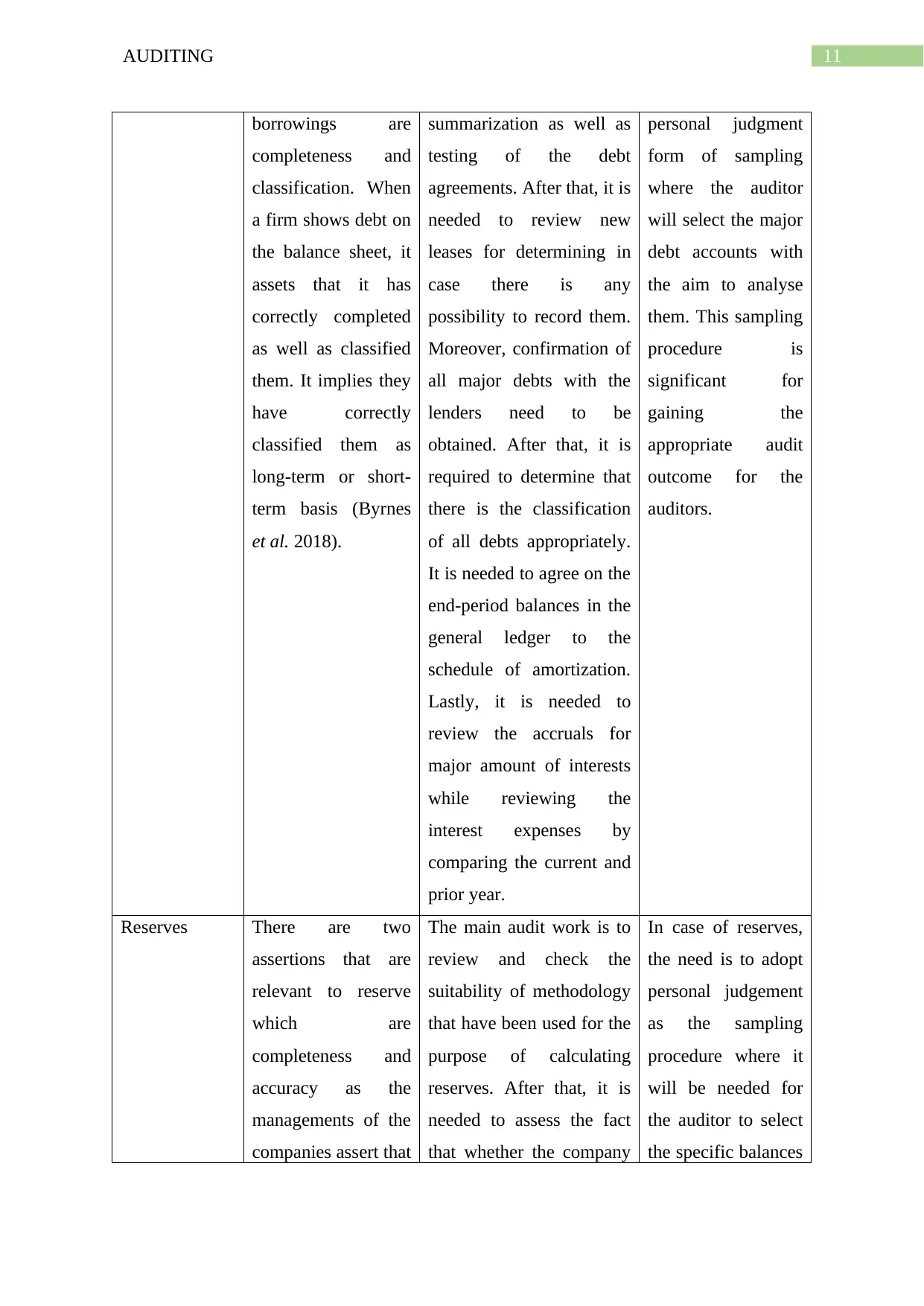
11AUDITING
borrowings are
completeness and
classification. When
a firm shows debt on
the balance sheet, it
assets that it has
correctly completed
as well as classified
them. It implies they
have correctly
classified them as
long-term or short-
term basis (Byrnes
et al. 2018).
summarization as well as
testing of the debt
agreements. After that, it is
needed to review new
leases for determining in
case there is any
possibility to record them.
Moreover, confirmation of
all major debts with the
lenders need to be
obtained. After that, it is
required to determine that
there is the classification
of all debts appropriately.
It is needed to agree on the
end-period balances in the
general ledger to the
schedule of amortization.
Lastly, it is needed to
review the accruals for
major amount of interests
while reviewing the
interest expenses by
comparing the current and
prior year.
personal judgment
form of sampling
where the auditor
will select the major
debt accounts with
the aim to analyse
them. This sampling
procedure is
significant for
gaining the
appropriate audit
outcome for the
auditors.
Reserves There are two
assertions that are
relevant to reserve
which are
completeness and
accuracy as the
managements of the
companies assert that
The main audit work is to
review and check the
suitability of methodology
that have been used for the
purpose of calculating
reserves. After that, it is
needed to assess the fact
that whether the company
In case of reserves,
the need is to adopt
personal judgement
as the sampling
procedure where it
will be needed for
the auditor to select
the specific balances
borrowings are
completeness and
classification. When
a firm shows debt on
the balance sheet, it
assets that it has
correctly completed
as well as classified
them. It implies they
have correctly
classified them as
long-term or short-
term basis (Byrnes
et al. 2018).
summarization as well as
testing of the debt
agreements. After that, it is
needed to review new
leases for determining in
case there is any
possibility to record them.
Moreover, confirmation of
all major debts with the
lenders need to be
obtained. After that, it is
required to determine that
there is the classification
of all debts appropriately.
It is needed to agree on the
end-period balances in the
general ledger to the
schedule of amortization.
Lastly, it is needed to
review the accruals for
major amount of interests
while reviewing the
interest expenses by
comparing the current and
prior year.
personal judgment
form of sampling
where the auditor
will select the major
debt accounts with
the aim to analyse
them. This sampling
procedure is
significant for
gaining the
appropriate audit
outcome for the
auditors.
Reserves There are two
assertions that are
relevant to reserve
which are
completeness and
accuracy as the
managements of the
companies assert that
The main audit work is to
review and check the
suitability of methodology
that have been used for the
purpose of calculating
reserves. After that, it is
needed to assess the fact
that whether the company
In case of reserves,
the need is to adopt
personal judgement
as the sampling
procedure where it
will be needed for
the auditor to select
the specific balances
⊘ This is a preview!⊘
Do you want full access?
Subscribe today to unlock all pages.

Trusted by 1+ million students worldwide
1 out of 18
Related Documents
Your All-in-One AI-Powered Toolkit for Academic Success.
+13062052269
info@desklib.com
Available 24*7 on WhatsApp / Email
![[object Object]](/_next/static/media/star-bottom.7253800d.svg)
Unlock your academic potential
Copyright © 2020–2025 A2Z Services. All Rights Reserved. Developed and managed by ZUCOL.




